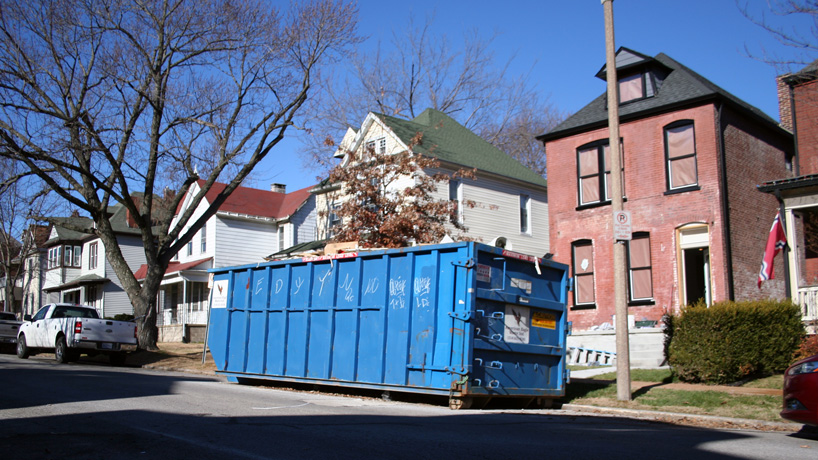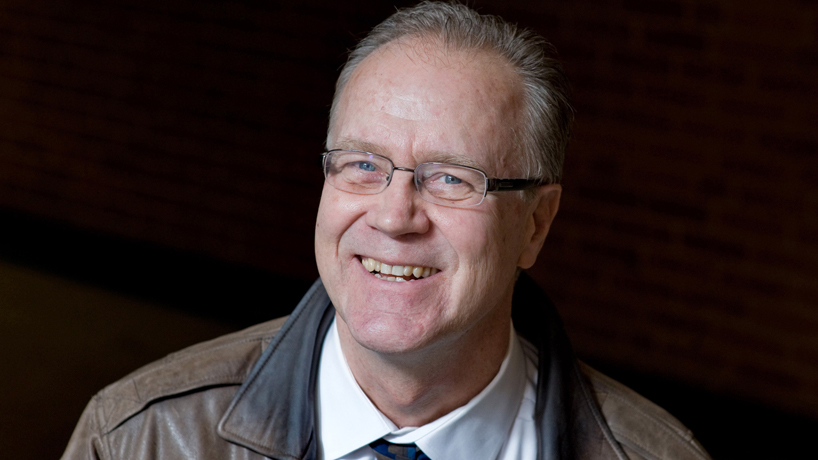
Researchers at UMSL’s Community Innovation and Action Center have been working in concert with members of the Home Repair Network to study the home repair needs of St. Louis residents and come up with a policy agenda to try to address them. (File photo)
Buildings with boarded-up windows, caving-in walls, and collapsing roofs are too common a sight in many St. Louis neighborhoods.
St. Louis’ vacancy problem didn’t happen overnight. Before homes and businesses are abandoned, owners often seek the resources to make repairs. Without help for repairs, conditions worsen and owners ultimately walk away.
Older homeowners living on low-and-fixed incomes are especially vulnerable with many struggling to maintain their aging homes. Expensive repairs like a leaky roof and malfunctioning heating and air-conditioning systems can leave owners with impossible choices about whether to pay for repairs or meet their other urgent needs.
Todd Swanstrom, the E. Desmond Lee Endowed Professor of Community Collaboration and Public Policy Administration at UMSL, was the principal investigator directing a study that examined the the need for and effectiveness of home repairs among older homeowners in St. Louis. (File photo)
“The thing is having to pick between, ‘Do I do home repair or do I pay this bill?’” said one of the 31 residents interviewed in a new study of home repair needs in the St. Louis region. “’Do I do a home repair or buy this medicine?’”
The tragic result is that people – especially older people – are oftentimes forced to live with increasingly urgent deferred maintenance issues for years, and they can reach the point where they often are forced to find other housing.
There’s a movement afoot in St. Louis to change that. The Community Innovation and Action Center at the University of Missouri–St. Louis has been studying this problem over the past 2½ years with the support of a $178,000 grant from the RRF Foundation for Aging. Researchers at CIAC have been working in concert with members of the Home Repair Network, a recently launched coalition of nonprofit home repair providers across the region who’ve received support from the St. Louis chapter of the Urban Land Institute.
Through their shared work, they have created a clear policy reform agenda for the Home Repair Network as it works to improve the home repair system in the St. Louis region. CIAC researchers and members of the Home Repair Network presented the report to local government officials and home repair supporters on Thursday at High Low on Washington Avenue in St. Louis.
“Until now, the only way to estimate the need for home repairs was to send inspectors into every home,” said Todd Swanstrom, the E. Desmond Lee Endowed Professor of Community Collaboration and Public Policy Administration at UMSL, who served as the principal investigator on the project. “That is very expensive. We have devised a new less expensive methodology based on people’s experience of their homes that can be used by any city to determine the need for home repairs and how much it would cost to fund them. A problem that was largely hidden from view can now be made much more visible.”
The partners have created a new online toolkit that advocates in peer cities can use to replicate their work.
“The report made obvious that the Home Repair Network was needed to advocate as a collective to improve home repair delivery for the region,” said Constance Siu, the executive director of the North Newstead Association who’s helping lead the Home Repair Network.
The research effort is the result of a collaboration among community organizations and home repair providers, including the Home Repair Network, Legal Services of Eastern Missouri, the St. Louis City Senior Fund, the St. Louis Vacancy Collaborative, the St. Louis Association of Community Organizations, the St. Louis Community Development Administration, Mission St. Louis, the Urban League of Metropolitan St. Louis, and Rebuilding Together St. Louis.
Swanstrom and colleagues from CIAC conducted two surveys with homeowners across the city, oversampling in low-income neighborhoods in north St. Louis to ensure that they were hearing from people most impacted by this problem. The researchers also conducted in-person interviews, exploring the impact of home repairs on the mental and physical health of older homeowners, as well as their financial well-being and ability to age in place with dignity.
The research revealed that:
- Average Cost of Needed Repairs: $13,023
- Total Needed to Address Repair Needs for All Older Homeowners in St. Louis: $302 million
- Average Age of Homes: 97 years
- Most Common Needed Repairs: Install Electrical Plugs and Weatherization
- Over 80% had an electrical outlet used for more than two devices (a fire risk).
- Many older homeowners lack properly functioning air conditioning, which can be deadly in a heat wave.
This is also an issue of environmental justice, as the report shows that Black homeowners living in historically disinvested neighborhoods are often the ones in most need of home repair services. St. Louis’ history of segregation, disinvestment, and redlining in North St. Louis City has led to neighborhoods where it is nearly impossible for owners to access the finances needed for home improvements.
“I’ve watched clients walk away and abandon their family homes because they simply cannot access the funds to keep it habitable,” said Peter Hoffman, managing attorney of neighborhood advocacy at Legal Services of Eastern Missouri. “There are no bank loans available in large portions of the city. For most people their home is the most valuable asset they’ll ever own. It’s hard-earned. Home repair can mean the difference between a family home and an abandoned house. It can literally save people from having to be put out on the street.”
Members of the research team and the Home Repair Network will also take part in the second annual Home Improvement Summit put on by the St. Louis Association of Community Organizations on June. 3.
Media Coverage
St. Louis Post-Dispatch















